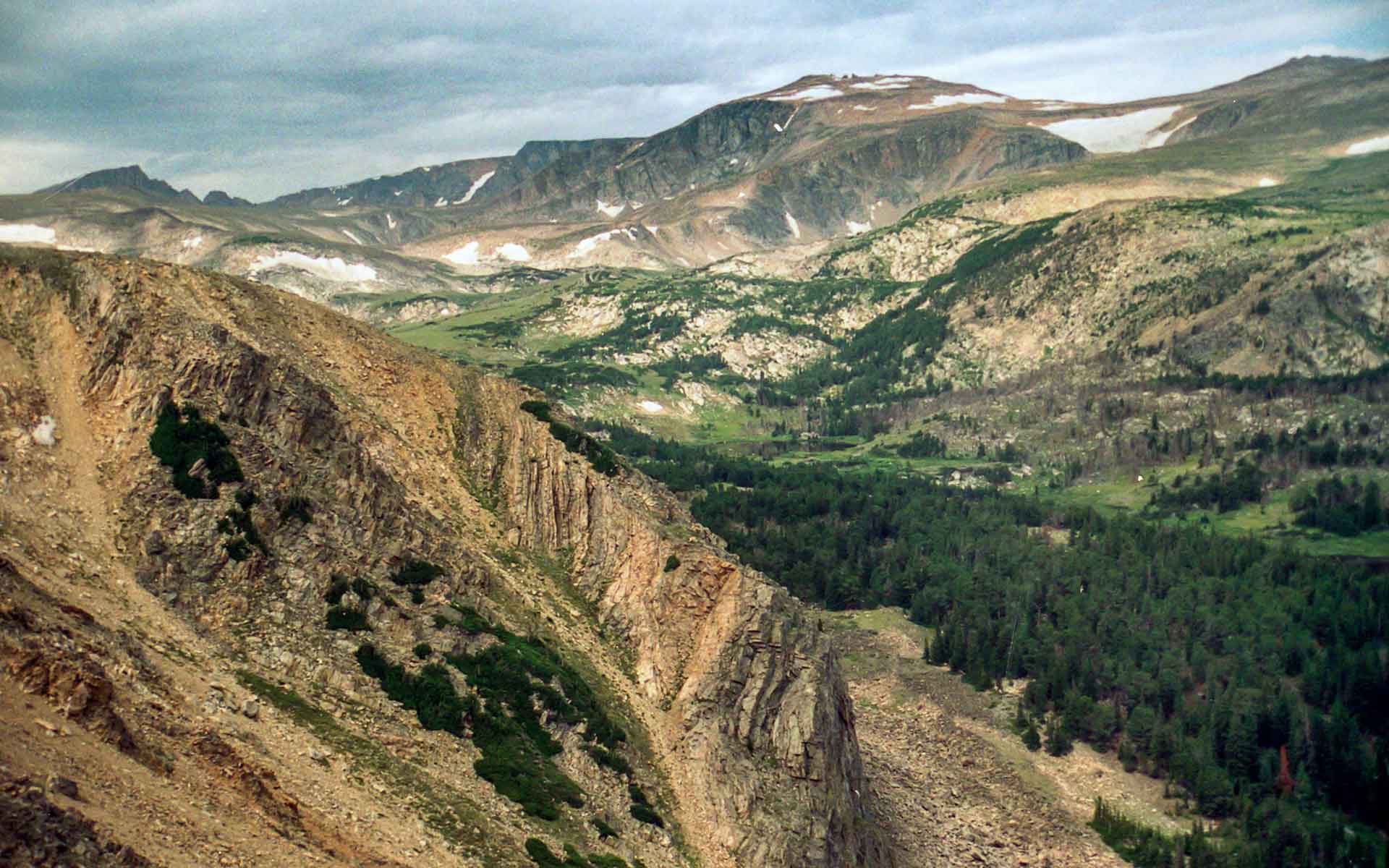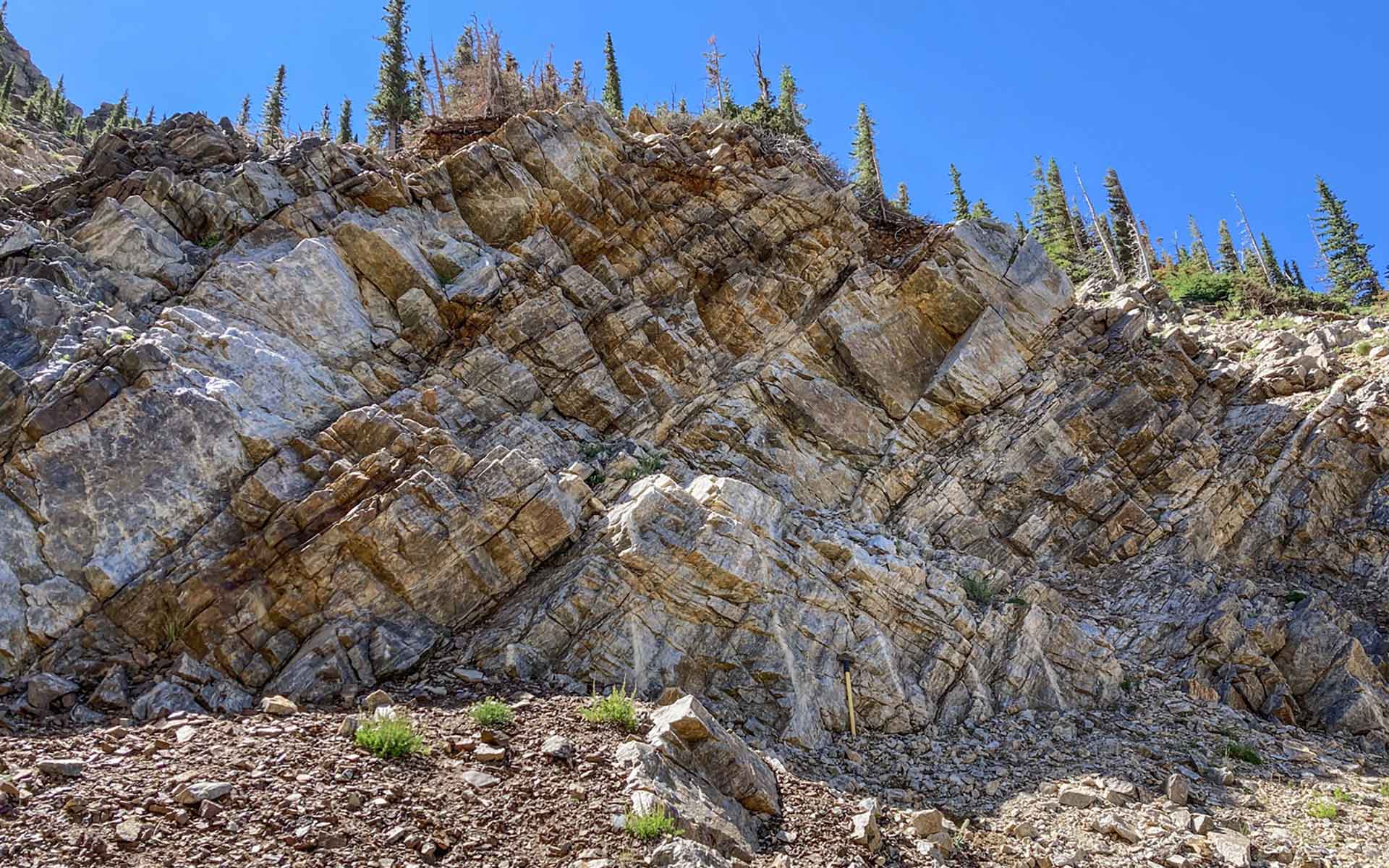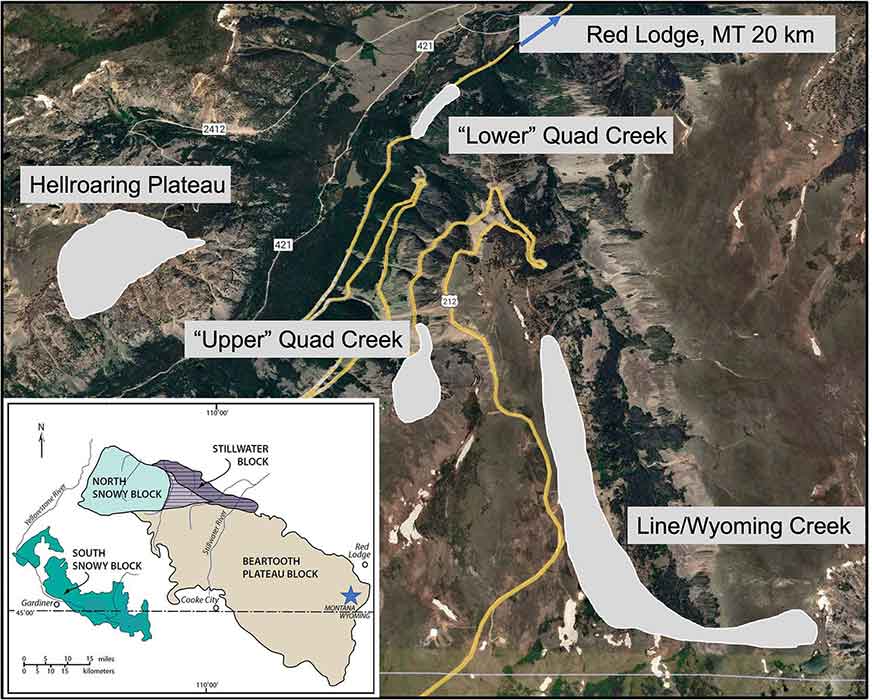
Interlayered 3.5-3.0 Ga TTG gneiss and metasupracrustal rocks (ridge in foreground) as a km-scale pendant in voluminous 2.8 Ga calc-alkaline magmatic rocks seen on the skyline, Hellroaring Plateau.
Geological Period
Paleo- to Mesoarchean
Main geological interest
Igneous and metamorphic petrology
Location
20 Km south of Red Lodge, Montana, USA.
45°01’45.0″N, 109°24’57.0″W
Interlayered 3.5-3.0 Ga TTG gneiss and metasupracrustal rocks (ridge in foreground) as a km-scale pendant in voluminous 2.8 Ga calc-alkaline magmatic rocks seen on the skyline, Hellroaring Plateau.
Archean rocks of the eastern Beartooth Mountains record early crustal genesis and evolution.
Archean crustal genesis and evolution are revealed: a) separation of mafic crust from the mantle in a plume-dominated tectonic environment (4.0-3.6 Ga); b) partial melting of mafic crust to produce the first tonalite-trondhjemite-granodiorite (TTG) continental nuclei (3.6-3.1 Ga; Mueller et al., 2014); c) stable platform sedimentation followed by convergent margin tectonics (2.8 Ga) produced calc-alkaline magmatic rocks by subduction processes comparable to a modern continental arc (Mueller et al., 2014; Mogk et al., 2020). The “granite controversy” is addressed in the gneiss which was originally interpreted as solid-state transformations (“granitization”; Eckelmann and Poldervaart, 1957) vs. magmatic processes (Mueller et al., 2010).
- Geological description
The eastern Beartooth Mountains contain pendants of Paleo-Mesoarchean high-grade gneiss intruded by voluminous Neoarchean calc-alkaline rocks (Mogk et al., 2020). The oldest gneiss is dominantly of the TTG suite in composition and crystallized 3.5-3.1 Ga based on U-Pb zircon geochronology (Mueller et al., 2014). This rock is ion bi-modal association with amphibolite and are tectonically interleaved with metasupracrustal rocks (Henry et al., 1982). Detrital zircons in quartzite reveal crust-forming events at ~4.0, 3.7, and 3.5 Ga with a major crust forming event at 3.3-3.2 Ga; the latest deposition occurred at ~3.0-3.1 Ga (Mueller and Wooden, 2012). The metasupracrustal rocks were deposited in tectonically quiescent environments and were subsequently tectonically mixed with bodies of gneiss and metamorphosed between 3.0 and 2.8 Ga at pressure-temperature conditions of ~680-750o C and 6-8 Kbar (20-25 km depth of burial). The deep burial of the supracrustal sequence results from crustal thickening via horizontal tectonics (Henry et al., 1982). The Neoarchean magmatic cycle occurred over a restricted time interval (2.83-2.79 Ga) and produced large volumes of rocks of intermediate and tonalitic composition, along with the first major occurrence of true granite (Mueller et al., 2010). The Neoarchean rocks are interpreted as the products of subduction analogous to a modern-day continental arc setting.
- Scientific research and tradition
The eastern Beartooth Mountains have been extensively studied for over 60 years, starting with detailed field studies (Eckelmann and Poldervaart, 1957) and continuing with modern analytical studies including major and trace element geochemistry, geochronology (U-Pb and Lu-Hf zircon, Nd-Sm, and Rb-Sr methods), isotopic tracers, and quantitative geothermobarometry (Mueller et al., 2014).
- Reference
Eckelmann, F.D. and Poldervaart, A. (1957) ‘Geologic Evolution of the Beartooth Mountains, Montana and Wyoming 1. Archean History of the Quad Creek Area’, GSA Bulletin, 68(10), pp. 1225–1262. Available at: https://doi.org/10.1130/0016-7606(1957)68[1225:GEOTBM]2.0.CO;2.
Henry, D. et al. (1982) ‘Granulite grade supracrustal assemblages of the Quad Creek area, eastern Beartooth Mountains, Montana’, Montana Bureau of Mines and Geology, Special Publication, 84, pp. 147–155.
Mogk, D.W., Mueller, P.A. and Henry, D.J. (2020) ‘The Archean Geology of Montana’, in Geology of Montana. The Montana Bureau of Mines and Geology (MBMG) (Montana Bureau of Mines and Geology Centennial Volume). Available at: https://mbmg.mtech.edu/pubs/GeologyOfMontana/
Mueller, P.A. et al. (2010) ‘Rapid growth of an Archean continent by arc magmatism’, Precambrian Research, 183(1), pp. 70–88. Available at: https://doi.org/10.1016/j.precamres.2010.07.013.
Mueller, P.A. et al. (2014) ‘The Plume to Plate Transition: Hadean and Archean Crustal Evolution in the Northern Wyoming Province, U.S.A.’, in Y. Dilek and H. Furnes (eds) Evolution of Archean Crust and Early Life. Dordrecht: Springer Netherlands (Modern Approaches in Solid Earth Sciences, v. 7), pp. 23–54. Available at: https://doi.org/10.1007/978-94-007-7615-9_2.
Mueller, P.A. and Wooden, J.L. (2012) ‘Trace Element and Lu-Hf Systematics in Hadean-Archean Detrital Zircons: Implications for Crustal Evolution’, The Journal of Geology, 120(1), pp. 15–29. Available at: https://doi.org/10.1086/662719.
- Author(s)
David W. Mogk
Dept. Earth Sciences, Montana State University, Bozeman, MT, USA
Paul A. Mueller
Dept. of Geological Sciences, Gainesville, FL, USA
Darrell J. Henry
Dept. of Geology and Geophysics, Baton Rouge, LA, USA


